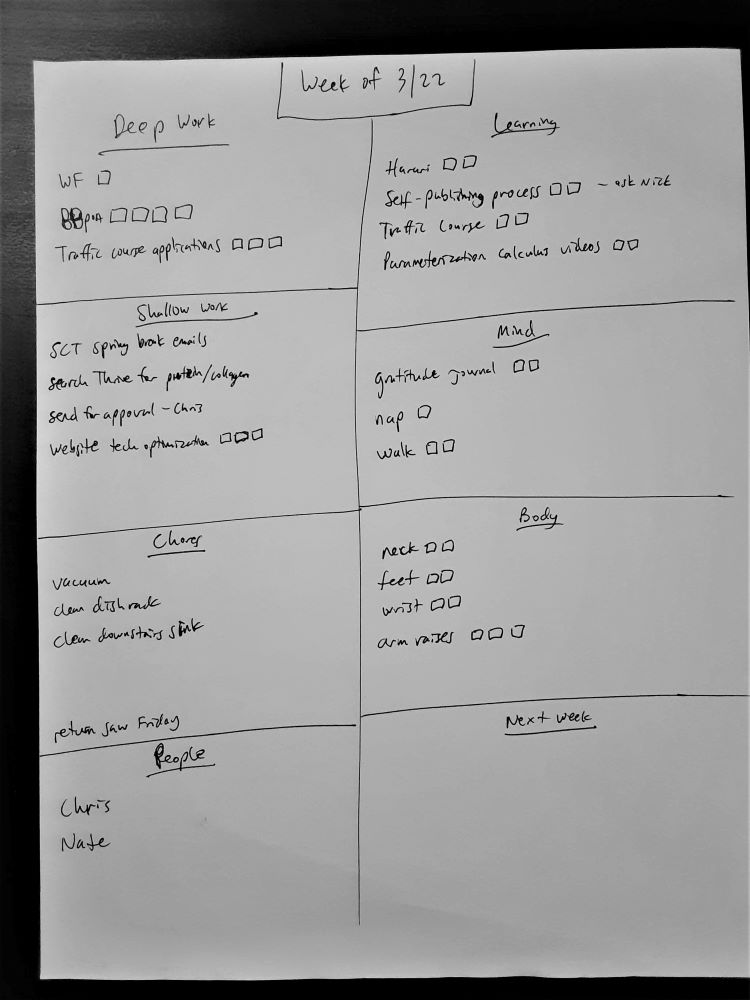
I’ve had a tumultuous relationship with to-do lists over the years.
On the one hand, I need them. They lighten my cognitive load and remind me of tasks that I would otherwise forget. They provide a menu of productive options when I’m unsure what to do with my time.
But on the other hand, I’ve found them to be unwieldy and even overwhelming. I used to just collect all possible to-dos on a single piece of paper. It was unorganized and unprioritized, so it was very difficult to look at the list and choose an appropriate task.
The first technique I adopted to improve my to-do lists was to break them up. So now there are separate lists for today, this week, soon, eventually, and maybe. This multi-level approach helped enormously, but it wasn’t enough.
Next, I realized that many tasks are not one-and-done; they’re things I’d like to work on incrementally. For these items, I’ve adopted a checkbox system: I put a few checkboxes next to the item, and if I put in some work, I track my progress by putting a check in one of the boxes.
And most recently, I’ve adopted a third strategy for improving my to-do lists: organizing them into categories.
To-Do List Categories
It began with differentiating between deep work and shallow work. Doing deep work requires uninterrupted focus and should be scheduled for times of day when my brain is at its best. Shallow work, on other hand, can be done haphazardly at times when my brain isn’t feeling so sharp. So it made sense to distinguish between deep-work tasks and shallow-work tasks on my list. And then, since this was helpful, I started adding more categories: chores, learning, mind care, body care, people, as well as a space for next week’s tasks.

If I’m in deep-work mode, I choose a task from the deep-work list. If it’s time for shallow work, I select a task from that list.
If I’d like to learn something, the list tells me what my learning goals are for the week.
If I’d like to get up from my computer and do some chores, the list provides a menu of options.
The mind-care and body-care sections serve as reminders to engage in rest and recovery activities, such as taking a nap. And, with the checkbox system, these sections function as a recovery-tracking tool.
Similarly, having a space for people reminds me to reach out to friends and family, which is something I might otherwise forget to do.
Lastly, having a space for next week prevents me from overloading myself with tasks for this week.
A More Organized Tomorrow
I also apply this technique to my daily to-do list. As I’m planning tomorrow, I organize what I’m planning to do into categories – deep work, shallow work, chores, and mind/body care – and I pull one or two items from the corresponding categories on my weekly to-do list.
In addition, I’ll note in the hour-by-hour breakdown section of my planner what I’ll be doing at a certain time – either the category of task, the specific task, or both. Planning out tomorrow with this level of detail might seem like overkill, but if you ever struggle with indecision, it’s worth it.
Sorting Out Your To-Dos
Whenever a new to-do list item falls onto my plate or pops into my head, I look at my lists and place it where it belongs. It might be an item for today. It might be a learning goal for this week. It might be a chore for next week. It might be a non-urgent task that belongs on my “soon” or “eventually” list. It could just be an idea that’s just a “maybe.” Everything has its place.
(Note: For long-term to-do list items, consider sorting them into the following categories: tasks, projects, and habits.)
In this way, using to-do list categories is applying the mise-en-place method to your organizational system itself. Mise-en-place is normally about putting things where they physically belong – in the kitchen or at your desk – but the efficiency it creates also extends to where your tasks and ideas belong. Chefs use mise-en-place to keep pace with what would otherwise be an overwhelming volume of food orders. Sorting your tasks and ideas into categories will help you manage what might otherwise feel like an overwhelming amount of things to do.
Here again are the categories I’m currently using on my weekly to-do lists:
- Deep Work
- Shallow Work
- Chores
- Learning
- Mind Care
- Body Care
- People
- Next Week
The categories that make sense for your life and your goals may be different, but I’m sure that sorting your tasks into whatever categories are right for you will be very helpful.
